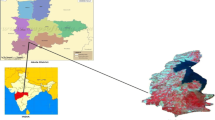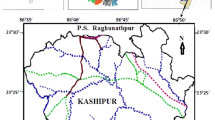Abstract
In this paper, an attempt has been made to delineate groundwater potential zones in Hingoli district, Maharashtra, India. Remote sensing and traditional data were collected from different sources and analysed in GIS software to prepare thematic maps of different geo-environmental factors such as lithology, drainage, lineaments, slope etc. as these factors having an impact on groundwater availability of an area, directly or indirectly. All these factors have been integrated into GIS software and multi influence factor method was applied to delineate groundwater potential zones. The result has shown about 50% area is having the good potentiality of groundwater, whereas about 6% region falls under very low potential area. The Central part of the study area is having very low groundwater potential, mainly due to the steep slope and rocky outcrop. The southern part of the Hingoli district has shown good groundwater potential, because of the gentle slope which influences water to infiltrate. All the major towns and villages are located in good groundwater prospect areas. Therefore, these locations do not experience extreme drought conditions. The present work is valuable for future planning and management of groundwater resource in Hingoli district.



Similar content being viewed by others
Notes
References
Saraf, A. K., & Choudhury, P. R. (1998). Integrated remote sensing and GIS for groundwater exploration and identification of artificial recharge sites. International Journal of Remote Sensing, 19, 1825–1841. doi:10.1080/014311698215018.
Keane, R. E., Burgan, R., & Wagtendonk, J. W. V. (2001). Mapping wildland fuels for fire management across multiple scales: Integrating remote sensing, GIS, and biophysical modeling. International Journal of Wildland Fire, 10, 301–319. doi:10.1071/WF01028.
Jha, M. K., Chowdhury, A., Chowdary, V. M., & Peiffer, S. (2006). Ground water management and development by integrated remote sensing and geographic information systems: Prospects and constraints. Water Resource Management, 21, 427–467. doi:10.1007/s11269-006-9024-4.
Solomon, S., & Quiel, F. (2006). Groundwater study using remote sensing and geographic information systems (GIS) in the central highlands of Eritrea. Hydrogeology Journal, 14, 1029–1041. doi:10.1007/s10040-006-0096-2.
Munch, Z., & Conrad, J. (2007). Remote sensing and GIS based determination of groundwater dependent ecosystems in the Western Cape, South Africa. Hydrogeology Journal, 15, 19–28. doi:10.1007/s10040-006-0125-1.
Dar, I. A., Sankar, K., & Dar, M. A. (2011). Deciphering groundwater potentialzones in hard rock terrain using geospatial technology. Environmental Monitoring and Assessment, 173, 597–610. doi:10.1007/s10661-010-1407-6.
Kumar, S. K., Chandrasekar, N., & Seralathan, P. (2012). Hydrogeochemical study of shallow carbonate aquifers, Rameswaram Island, India. Environmental Monitoring and Assessment, 184, 4127–4138. doi:10.1007/s10661-011-2249-6.
Mekki, O. A. E., & Laftouhi, N. (2016). Combination of a geographical system and remote sensing data to map ground water recharge potential in arid to semi-arid areas: The Haouz Plain, Morocco. Earth Science Informatics, 9, 465–479. doi:10.1007/s12145-016-0268-0.
Ravindran, K. V., & Jeyram, A. (1997). Ground water prospects of Shahbad Teshil, Baran District, Eastern Rajasthan: a remote sensing approach. Journal of the Indian Society of Remote Sensing, 25(4), 239–246. doi:10.1007/BF03019365.
Kumar, A., Tomar, S., & Prasad, L. B. (1999). Analysis of fractured inferred from DBTM and remotely sensed data for groundwater development in Godavari sub-watershed, Giridih, Bihar. Journal of the Indian Society of Remote Sensing, 26(2), 105–114. doi:10.1007/BF02990806.
Appleyard, S. J. (1995). The impact of urban development on recharge and groundwater quality in the coastal aquifer near Perth, Western Australia. Hydrogeology Journal, 3(2), 65–75. doi:10.1007/s100400050072.
Lerner, D. N. (2002). Identifying and quantifying urban recharge: A review. Hydrogeology Journal, 10(1), 18–39. doi:10.1007/s10040-001-0177-1.
Brunner, P., Bauer, P., Eugster, M., & Kinzelbach, W. (2004). Using remote sensing to regionalize local precipitation recharge rates obtained from the chloride method. Journal of Hydrology, 294(4), 241–250. doi:10.1016/j.jhydrol.2004.02.023.
Tweed, S., Leblanc, M., Webb, J., & Lubczynski, M. (2007). Remote sensing and GIS for mapping groundwater recharge and discharge areas in salinity prone catchments, southeastern Australia. Hydrogeology Journal, 15(1), 75–96. doi:10.1007/s10040-006-0129-x.
Mukherjee, P., Singh, C. K., & Mukherjee, S. (2012). Delineation of groundwater potential zones in arid region of India: A remote sensing and GIS approach. Water Resource Management, 26(9), 2643–2672. doi:10.1007/s11269-012-0038-9.
Sarath Prasanth, S. V., Magesh, N. S., Jitheshlal, K. V., Chandrasekar, N., & Gangadhar, K. (2012). Evaluation of groundwater quality and its suitability for drinking and agricultural use in the coastal stretch of Alappuzha District, Kerala, India. Applied Water Science, 2(3), 165–175. doi:10.1007/s13201-012-0042-5.
Das, S., Behera, S. C., & Kar, A. (1997). Hydrogeomorphological mapping in ground water exploration using remotely sensed data: A case study in Keonjhar District, Orissa. Journal of the Indian Society of Remote Sensing, 25, 247–259. doi:10.1007/BF03019366.
Jain, P. K. (1998). Remote sensing techniques to locate ground water potential zones in upper Urmil River Basin, district Chhatarpur—central India. Journal of the Indian Society of Remote Sensing, 26(3), 135–147. doi:10.1007/BF03026671.
Thomas, A., Sharma, P., Sharma, M., & Anil, S. (1999). Hydrogeomorphological mapping in assessing groundwater by using remote sensing data: A case study in Lehra Gage Block, Sangrur district, Punjab. Journal of the Indian Society of Remote Sensing, 27, 31–42.
Muralidhar, M., Raju, K. R., Raju, K. S. V. P., & Prasad, J. R. (2000). Remote sensing applications for the evaluation of water resources in rainfed area, Warangal district, Andhra Pradesh. Indian Mineral, 34, 33–40.
Srivastava, P., & Bhattacharya, A. (2000). Delineation of ground water potential zones in a hard rock terrain of Bargarh district, Orissa using IRS data. Journal of the Indian Society of Remote Sensing, 28(2–3), 129–140. doi:10.1007/BF02989897.
Lokesha, N., Gopalakrishna, G. S., Gowda, H. H., & Gupta, A. K. (2005). Delineation of ground water potential zones in a hard rock terrain of Mysore district, Karnataka using IRS data and GIS techniques. Journal of the Indian Society of Remote Sensing, 33(3), 405–412. doi:10.1007/BF02990011.
Magesh, N. S., Chandrasekar, N., & Soundranayagam, J. P. (2012). Delineation of groundwater potential zones in Theni district, Tamil Nadu, using remote sensing, GIS and MIF techniques. Geoscience Frontier, 3, 189–196. doi:10.1016/j.gsf.2011.10.007.
Kaliraj, S., Chandrasekhar, N., & Magesh, N. S. (2014). Identification of potential groundwater recharge zones in Vaigai upper basin, Tamil Nadu, using GIS-based analytical hierarchical process (AHP) technique. Arabian Journal of Geosciences, 7, 1385–1401. doi:10.1007/s12517-013-0849-x.
Ramasamy, S. M., & Anbazhagan, S. (1997). Criteria and techniques of detecting site specific mechanisms for artificial recharge: A case study from Ayyar basin, India. Journal of Geological Society of India, 50, 449–456.
Teeuw, R. M. (1995). Groundwater exploration using remote sensing and a low-cost geographical information system. Hydrogeology Journal, 3, 21–30. doi:10.1007/s100400050057.
Nag, S. K. (2005). Application of lineament density and hydrogeomorphology to delineate groundwater potential zones of Baghmundi block in Purulia district, West Bengal. Journal of the Indian Society of Remote Sensing, 33, 521–529. doi:10.1007/BF02990737.
Murthy, K. S. R. (2000). Ground water potential in a semi-arid region of Andhra Pradesh: A geographical information system approach. International Journal of Remote Sensing, 21, 1867–1884.
Biswas, A., Jana, A., & Sharma, S. P. (2012). Delineation of groundwater potential zones using satellite remote sensing and geographic information system techniques: A case study from Ganjam district, Orissa, India. Research Journal of Recent Science, 1(9), 59–66.
Biswas, A., Jana, A., & Mandal, A. (2013). Application of remote sensing, GIS and MIF technique for elucidation of groundwater potential zones from a part of Orissa coastal tract, Eastern India. Research Journal of Recent Science, 2(11), 42–49.
Deepa, S., Venkateswaran, S., Ayyandurai, R., Kannan, R., & Prabhu, M. V. (2016). Groundwater recharge potential zones mapping in upper Manikuktha sub basin Vellar river Tamil Nadu India using GIS and remote sensing techniques. Modelling in Earth System and Environment, 2, 137.
Shaban, A., Khawlie, M., & Abdallah, C. (2006). Use of remote sensing and GIS to determine recharge potential zones: The case of Occidental Lebanon. Hydrogeology Journal, 14(4), 433–443. doi:10.1007/s10040-005-0437-6.
Tandon, S. K., Chakraborty, P. P., & Singh, V. (2014). Geological and tectonic framework of India: providing context to geomorphic development. In V. S. Kale (Ed.), Landscapes and landforms of India (pp. 3–14). New York: Springer.
Horton, R. E. (1932). Drainage basin charecterstics. Transactions of American Geophysical Union, 13, 350–361.
Prasad, R. K., Mondal, N. C., Banerjee, P., Nandakumar, M. V., & Singh, V. S. (2008). Deciphering potential groundwater zone in hard rock through the application of GIS. Environmental Geology, 55, 467–475. doi:10.1007/s00254-007-0992-3.
Shankar, M. N. R., & Mohan, G. (2006). Assessment of the groundwater potential and quality in Bhatsa and Kalu river basins of Thane district, western Deccan Volcanic Province of India. Environmental Geology, 49, 990–998. doi:10.1007/s00254-005-0137-5.
Acknowledgements
The authors wish to thank Jung-Sup Um (editor-in-chief, Spatial Information Research) for his valuable suggestions in improving the revised manuscript. Critical review and constructive comments from the anonymous reviewers significantly improved the final paper.
Author information
Authors and Affiliations
Corresponding author
Ethics declarations
Conflict of interest
On behalf of all authors, the corresponding author states that there is no conflict of interest.
Electronic supplementary material
Below is the link to the electronic supplementary material.
Rights and permissions
About this article
Cite this article
Das, S., Gupta, A. & Ghosh, S. Exploring groundwater potential zones using MIF technique in semi-arid region: a case study of Hingoli district, Maharashtra. Spat. Inf. Res. 25, 749–756 (2017). https://doi.org/10.1007/s41324-017-0144-0
Received:
Revised:
Accepted:
Published:
Issue Date:
DOI: https://doi.org/10.1007/s41324-017-0144-0




